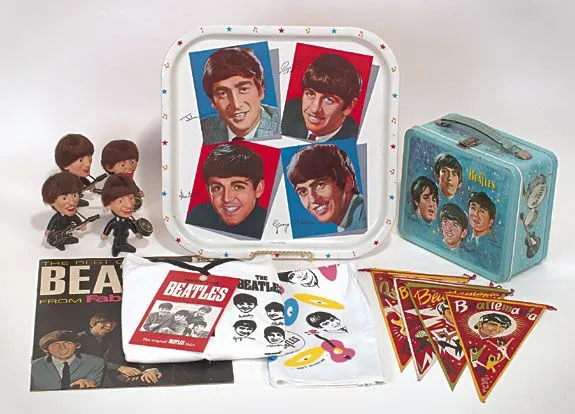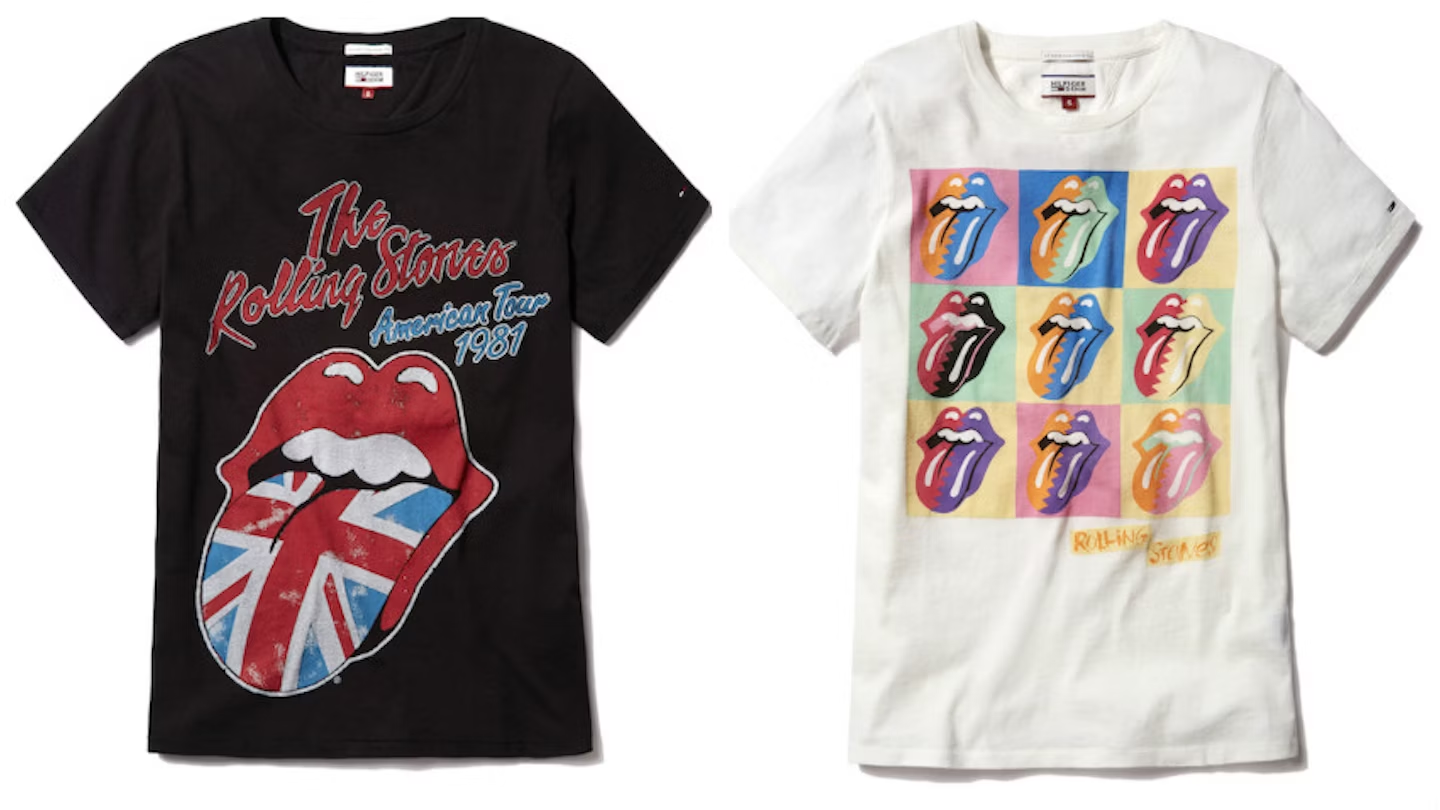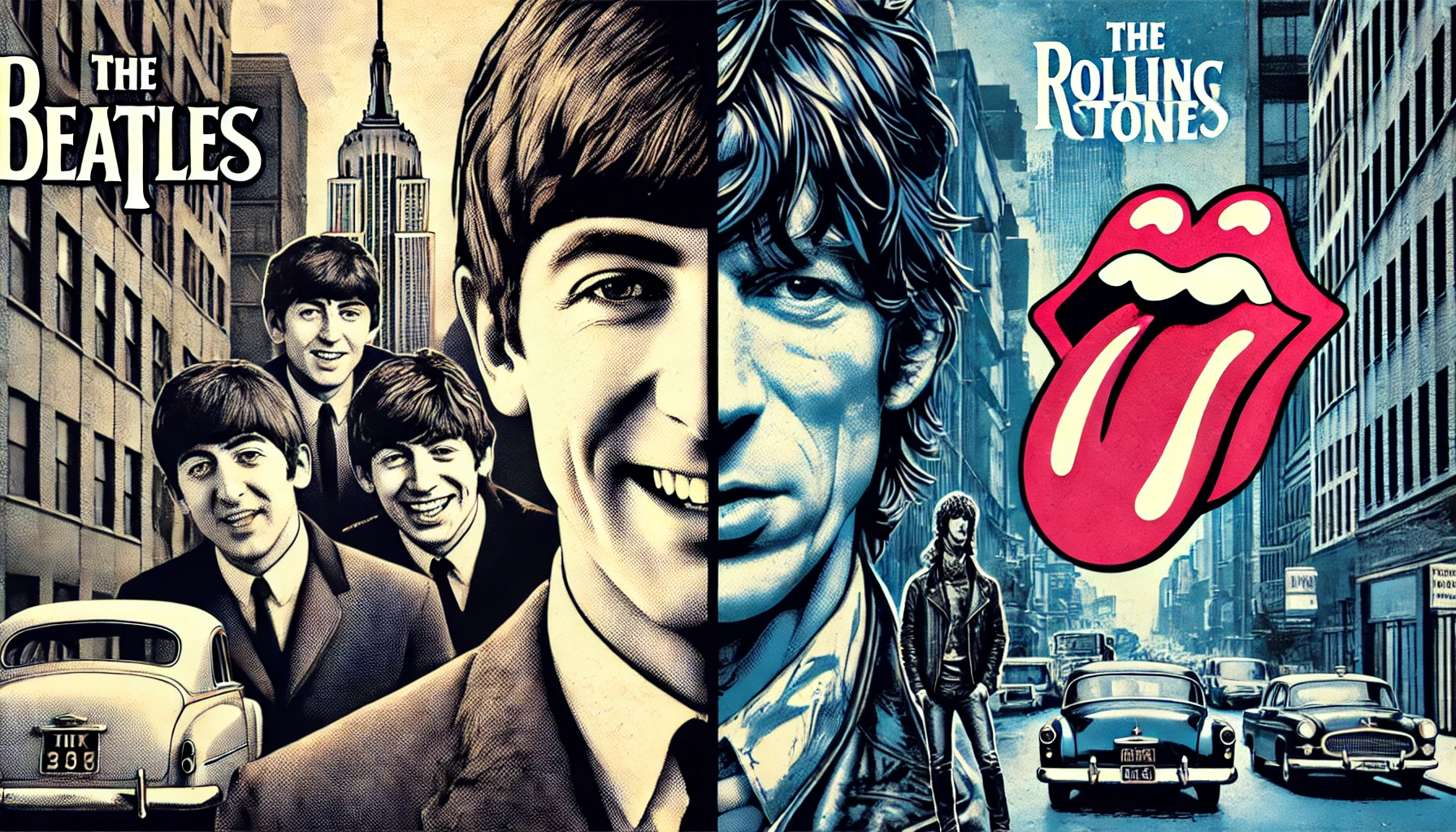The Beatles vs The Rolling Stones
A Study in Branding, Subcultures, and Reinvention
Few rivalries in music history have been as enduring or as commercially influential as The Beatles versus The Rolling Stones. More than just a battle of British bands, their competition shaped pop culture, influenced fan identities, and became a masterclass in branding, marketing, and subcultural segmentation. From their contrasting images to their approach to reinvention and monetisation, the Beatles-Stones dynamic provides a fascinating lens through which to analyse core marketing principles.
The Marketing Made Clear Podcast
This article features content from the Marketing Made Clear podcast. You can listen along to this episode on Spotify:
Branding: The Beatles’ Clean-Cut Charm vs. The Stones’ Rebellious Edge
While both bands emerged from the same post-war British music scene, they cultivated starkly different brand personas. The Beatles, managed by Brian Epstein, were polished, charming, and suited – a conscious move to appeal to a mainstream audience. They were marketed as accessible, friendly, and universally palatable. This was a textbook example of brand positioning, aligning the Fab Four with wholesome pop culture.
The Rolling Stones, under the guidance of Andrew Loog Oldham, took a different route. Oldham saw an opportunity to position the band as the antithesis of The Beatles (in this sense – almost a counter-culture). Where The Beatles were clean-cut, The Stones were dangerous; where The Beatles played to screaming teenage girls, The Rolling Stones exuded a grittier, blues-driven masculinity. Oldham famously encouraged the press to print the phrase:
“Would you let your daughter marry a Rolling Stone?”
…a brilliant piece of brand differentiation that aligned the band with rebellion and counterculture.
This branding divergence played a crucial role in shaping consumer perception. The concept of ‘brand personality’ (Aaker, 1997) suggests that consumers engage with brands that reflect their own self-image. Beatles fans were often seen as optimists, romantics, and mainstream pop lovers, while Stones fans leaned towards individualism, raw energy, and anti-establishment sentiments. This split in fandom is an early example of how brands create tribalism, an idea later explored by Cova and Cova (2002) in their study of brand communities.
The Beatles’ Failure in Monetising Their Own Image Rights
One of the greatest marketing missteps in the history of music commerce was The Beatles’ failure to capitalise on their own image rights. Their early contracts with Brian Epstein and EMI meant they saw little of the revenue generated by merchandising and licensing deals. Unlike modern artists who fiercely protect their intellectual property (as seen in Taylor Swift’s battle for her masters), The Beatles were locked into disadvantageous agreements, allowing outside parties to profit immensely from their likenesses.
In contrast, The Rolling Stones, particularly Mick Jagger, took a far more business-savvy approach. By the early 1970s, Jagger had restructured the band’s financial affairs, incorporating their business in tax-friendly jurisdictions and ensuring greater control over their catalogue and branding. The Stones‘ approach mirrors strategic brand management principles (Keller, 2013), where a brand’s long-term equity is meticulously cultivated and controlled.
While The Beatles eventually rectified some of these errors (Paul McCartney’s acquisition of publishing rights in later years being a prime example), their early missteps demonstrate the importance of long-term brand equity management.

Google Trends: Interest in The Rolling Stones and The Beatles over Time:
The Beatles and Commercial Partnerships
While The Beatles never officially endorsed products, their massive cultural influence led to an explosion of licensed merchandise. From lunchboxes to wigs, toy guitars, and even breakfast cereals, their image was plastered on a wide range of products – often without them profiting due to their early poor licensing agreements. Later, Paul McCartney and Apple Corps took legal action to regain control over their brand and prevent unauthorised usage.
One notable indirect sponsorship connection is The Beatles‘ long-running dispute with Apple Inc. over the use of the “Apple” name. Originally, The Beatles’ Apple Corps was meant to be a multimedia company, and its branding clashed with Apple Inc.’s rise in the tech industry. This led to a series of lawsuits and settlements, eventually culminating in an agreement where Apple Inc. secured the rights to the name in relation to technology, while Apple Corps retained rights to music-related branding.
The Rolling Stones and Brand Collaborations
The Rolling Stones took a more business-savvy approach to branding, and while they did not engage in direct product endorsements in their early years, they later became more commercially strategic. By the 1990s and beyond, they embraced corporate sponsorships in ways that aligned with their image. For example:
- Tommy Hilfiger Sponsorship (1999): The brand sponsored the Stones’ No Security tour, capitalising on their rock-and-roll aesthetic and rebellious edge.
- Mercedes-Benz (2016): The Stones’ music was used in advertising campaigns, aligning luxury with their enduring cool factor.
- Bespoke Brand Partnerships: The band has lent its name and likeness to branded merchandise, including special edition alcoholic beverages, fragrances, and even slot machines.
Other collaborations include; Paul Smith, Volvo, Phix, Brain Dead and Supervinyl, and many more.
Mick Jagger, known for his keen business acumen, ensured that the band retained control over their image and maximised revenue from commercial collaborations.
Several musical instruments saw a surge in popularity after being prominently used by The Beatles and The Rolling Stones. The influence of these bands extended beyond their music, directly impacting the instruments that musicians aspired to play. This phenomenon aligns with marketing concepts such as aspirational branding and influencer marketing, where products become desirable because they are associated with influential figures.
The Beatles and Their Instrumental Influence
The Beatles were known for their unique sound, which was partially shaped by their choice of instruments. Some of the most iconic ones include:
- Höfner 500/1 Violin Bass – Paul McCartney’s use of the Höfner bass, often referred to as the “Beatle Bass,” made it one of the most recognisable instruments in music history. The lightweight and symmetrical design suited McCartney’s left-handed playing, and its distinctive tone became synonymous with early Beatles recordings.
- Rickenbacker Guitars – John Lennon’s use of a Rickenbacker 325 helped boost the brand’s reputation. George Harrison later popularised the Rickenbacker 360/12, making the 12-string electric guitar a staple in the jangle-pop sound that influenced later bands like The Byrds.
- Ludwig Drum Kit and Zildjian Cymbals– Ringo Starr’s use of Ludwig drums propelled the brand to international fame. The Ludwig logo, prominently displayed on his bass drum, became an advertisement in itself as The Beatles performed on television and in front of massive audiences.
The Rolling Stones and Their Instrumental Choices
The Rolling Stones, with their blues-influenced sound, also contributed to the popularisation of specific instruments:
- Gibson Les Paul and Fender Telecaster – Keith Richards’ use of the Gibson Les Paul Standard in the early Stones years helped cement its reputation as a premier rock guitar. Later, his distinctive “five-string open G” tuning on a Fender Telecaster created a unique rhythm guitar style that influenced countless musicians.
- Gretsch Guitars and Gretsch Drums – Brian Jones frequently played Gretsch guitars, giving them visibility in the British rock scene while Charlie Watts played Gretsch Drums and Ufip Cymbals although he also played with Ludwig Drums at other parts of his career.
- Hohner Blues Harp – Mick Jagger’s use of the Hohner harmonica reinforced its association with rock and blues music, inspiring generations of harmonica players.
Marketing Perspective: The Power of Artist Endorsements
The increased sales of these instruments after The Beatles and The Rolling Stones used them exemplify the power of aspirational marketing. Similar to how sports endorsements drive demand for athletic gear, seeing legendary musicians use specific instruments influenced purchasing decisions among aspiring musicians. This also ties into product placement strategies, where brands benefit from high-profile, organic exposure.

Subcultural Marketing: Why Are You a Beatles or a Stones Fan?
The enduring question – are you a Beatles fan or a Rolling Stones fan? – has deep roots in subcultural marketing. The idea that consumers identify with a brand not just for its product but for the identity it offers is well explored in academic literature. Pierre Bourdieu’s concept of ‘distinction’ (1984) suggests that consumer choices are a form of social differentiation, a way to signify taste and belonging.
In the 1960s, this played out in youth culture, where Beatles fans often aligned with the optimistic, melodic, and artistic sensibilities of the band, whereas Stones fans identified with rebellion, authenticity, and blues-driven rock. These choices weren’t just musical – they were social statements. Much like Nike and Adidas in sportswear, Apple and Microsoft in technology, or even Pepsi and Coca-Cola in soft drinks, The Beatles and The Stones forced consumers into an implicit brand allegiance.
This segmentation extended beyond just music. Beatles fans might have been more likely to be drawn to pop art and classical influences (e.g., McCartney’s admiration for avant-garde), whereas Stones fans embraced the emerging rock subculture. In marketing terms, this was an early example of tribal marketing (Cova & Cova, 2002), where brands (or bands) become focal points of identity rather than just providers of products.
Reinvention and Sustained Relevance
One of The Beatles’ most remarkable marketing strategies – whether intentional or instinctive – was their ability to reinvent themselves. They did not remain static. From the mop-topped, Merseybeat phase to the psychedelia of Sgt. Pepper and the raw experimentation of The White Album, The Beatles continuously evolved. This aligns with the product lifecycle theory (Levitt, 1965), where brands must refresh themselves to avoid decline.
The Rolling Stones, while also adapting, took a different approach. Rather than reinventing themselves in drastic cycles, they reinforced their brand consistency. The Stones always retained their bluesy core while making incremental updates to stay relevant, much like how brands like Harley-Davidson have maintained their rebellious image while modernising their offerings.

Other Marketing Theories Linked to the Rolling Stones vs. The Beatles
Beyond branding and reinvention, there are several marketing theories that can be applied to the Beatles-Stones rivalry. Their contrasting strategies and long-term success align with fundamental marketing concepts, from brand positioning to the diffusion of innovations. These theories not only help explain the fan dynamics of the 1960s but also provide insights into broader consumer behaviour trends that remain relevant today.
1. The Diffusion of Innovations Theory (Rogers, 1962)
The Beatles can be viewed as early adopters of new trends, pioneering recording techniques, album concepts, and artistic directions that redefined music. Their ability to innovate and influence aligns with Rogers’ model of how new ideas spread through cultures. The Rolling Stones, in contrast, represent the “early majority” or even “late majority” in some respects, refining and commercialising the rebellious rock genre in a way that sustained long-term appeal.
2. Positioning Theory (Ries & Trout, 1981)
The Beatles and The Rolling Stones exemplify classic brand positioning. The Beatles positioned themselves as the creative, progressive, and sophisticated option, while the Stones positioned themselves as the raw, dangerous, and rebellious alternative. This mirrors modern brand battles such as Apple vs. Samsung or Mercedes vs. BMW – both appeal to similar markets but with distinct brand identities that resonate with different consumer values.
3. The Hero’s Journey & Brand Storytelling (Campbell, 1949)
Both bands crafted powerful brand narratives, but in different ways. The Beatles had an arc that followed Joseph Campbell’s ‘Hero’s Journey,’ transforming from youthful dreamers to global superstars, eventually dissolving due to internal conflicts—an archetypal ‘rise and fall’ story that continues to captivate fans. The Stones, meanwhile, have played the ‘survivors,’ maintaining their identity through consistency, echoing long-running legacy brands like Coca-Cola.
4. The Experience Economy (Pine & Gilmore, 1999)
The Beatles were pioneers in turning music into an experience beyond just albums – whether through their groundbreaking concerts, experimental studio work, or cultural movements like Beatlemania. The Rolling Stones, on the other hand, perfected the art of live performance, making concerts a cornerstone of their business model. This reflects modern experiential marketing, where brands sell an emotional experience rather than just a product (e.g., Red Bull’s extreme sports sponsorships).
5. The Blue Ocean Strategy (Kim & Mauborgne, 2005)
The Beatles constantly innovated, creating ‘blue oceans’ – new, untapped markets – through genre-blending and studio experimentation. They avoided direct competition by redefining what a rock band could be. The Stones, in contrast, thrived in a ‘red ocean’ strategy, competing fiercely within the rock-and-roll space but doing it better than anyone else. This is analogous to how Apple innovated with the iPhone, while Samsung competes through refinements and enhancements.
6. Maslow’s Hierarchy of Needs (1943) & Emotional Branding
The Beatles tapped into self-actualisation needs – offering deeper meaning, artistic expression, and countercultural ideologies. Their music evolved to reflect philosophical, existential, and social themes. The Rolling Stones, by contrast, remained more primal, focusing on base-level emotional experiences – desire, rebellion, and raw energy. This differentiation is akin to how brands market premium luxury (e.g., Tesla, which represents innovation and idealism) vs. hedonistic pleasure (e.g., Ferrari, which markets thrill and exclusivity).
The Legacy of Two Marketing Giants
The Beatles and The Rolling Stones were not just rock bands – they were brands, cultural movements, and marketing case studies in their own right. The Beatles mastered reinvention and storytelling but fell victim to poor intellectual property management. The Stones, meanwhile, capitalised on consistency, brand differentiation, and business acumen.
Their rivalry, whether real or exaggerated, was a masterclass in brand positioning, subcultural segmentation, and long-term brand strategy. And while the music industry has evolved, the Beatles vs. Stones debate remains a shining example of how marketing principles can be found even in the world’s greatest rock ‘n’ roll feuds.


